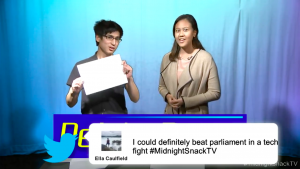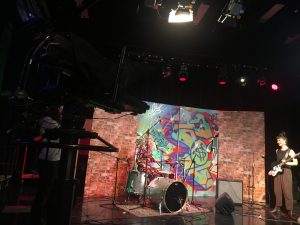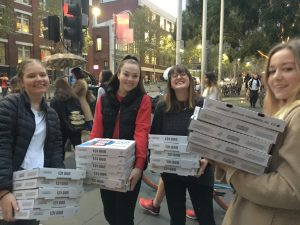It’s finally D-DAY, which means that we finally get to Livestream the hard work that my studio class has done over the past weeks. We had a call time of about 6.5 hours, 1:30 PM until we go live that is. Before I delve into what happened into our first day of live streaming, I’d like to about the theories behind our practice just to clear the air about the theories we aim to follow through as a studio.
Let’s begin with Sorensen’s discussion of live TV and its relevance in this day and age. To be exact, I’m discussing it in parallel with my role as a Livestream operator. Afterall, Sorensen does discuss the concept of liveness in a multiplatform context. In relation to Sorensen’s discussions amongst his reading, he focuses particularly on the concept of attracting an audience through the new technology that is social media – of course, it both “complements and complicates” the process of live television. Liveness has always been central to most television programmes, enabling producers to create more quality content and give it a feel of authenticity. As a Livestream operator, Sorensen’s theories line up in conjunction with what the Marketing/Social Media team and I have done in order to attract more audience in real life and on the live stream.
I am only secondary to the marketing team so really, I was just the medium to relay the messages from Twitter to the Livestream. For example, the Marketing team would have their laptop ready just to watch our for live tweets – the software “Livestream’ immediately catches these live tweets and it is my job to make sure that these tweets are projected during the live stream. As Sorensen states, the “uptake of Internet-enabled portable media and devices complicates and complements these developments” – I experienced both sides of complication but also the benefits that came with the involvement of social media in a live setting. In terms of the difficulties that I encountered, it was all about the timing between the segments of the show and whether it was the right time to put up the live tweets. One of the main problems was when I accidentally put a tweet over an important segment. This accidentally covered the graphics that was meant to be read by the audience but luckily I was able to remove it just in time.
I also did encounter some more problems but halfway through the show, I got more into the groove of putting the live tweets in and out at the right time. This proves Sorensen’s statement that this interaction between social media and live streaming complicates the whole process.
Despite the complications, we also encountered the good side of this advancement. It added to the overall aesthetic of the whole show including authenticity and legitimacy as a live television show. During the times I did get the timing right, I felt a sense of accomplishment running the show as a Livestream operator.
The Livestream machine
From the start of call time (which was 1 PM) until we went live, I basically familiarised myself with the overall setting of the set and even the control room. I wanted to remember which studio role my peers took over or were responsible for. When it came to setting up, I moved the cameras in the required manner and also looked out for some OH&S protocols that needed to be double-checked. I do want to address one thing that was a potential hazard that could’ve ended in total disaster. A certain group of people did not really know how to safely behave in the studio – I witnessed running, mishandling of the camera wires, a person placing their foot on the control table. It was honestly a big mess. I was in no position to tell them off because I feel like I wouldn’t have been able to handle the situation properly. However, they did take the set more seriously once we were going live which was a relief.
Despite that, we had a smooth running live television show and I am overall, impressed with the outcome of our work. The one thing that stood out to me the most was the Graphics – good job to whoever was in charge of creating that. One last complaint though – my name wasn’t in the credits. Boo.
Even though I experienced the negative side of collaborating with different groups of people, I did also go through a new learning experience. I asked people with different studio roles questions what their responsibilities were in order for me to be prepared the next time I take over that particular role. What this whole collaboration has taught me about liveness and a multi-camera production is that:
- there needs to be a whole of pre-production and preparation involved before actually going live
- communication is key in all areas of the studio – whether you are a producer or a camera operator
- mistakes will happen during a live broadcast and all you can do is move on
- in short, the SHOW MUST GO ON!
Here are some photos I took during the bumping in of the set, preparation in the control room and of course, the pizza perk!
Looking forward to our second and final episode of Midnight Snack. Woo! Bring it on!





